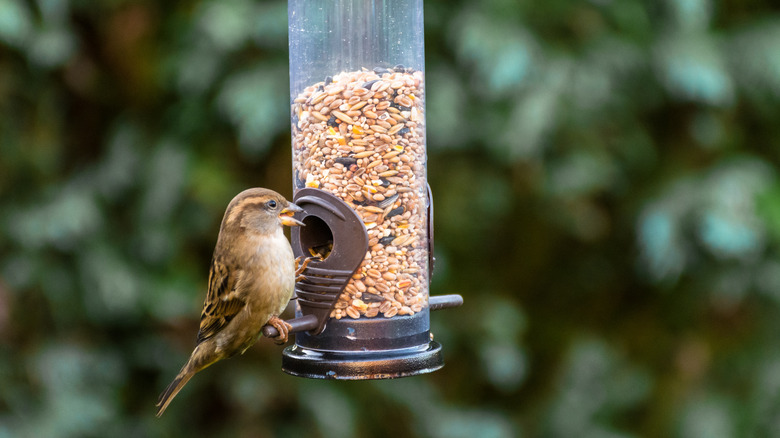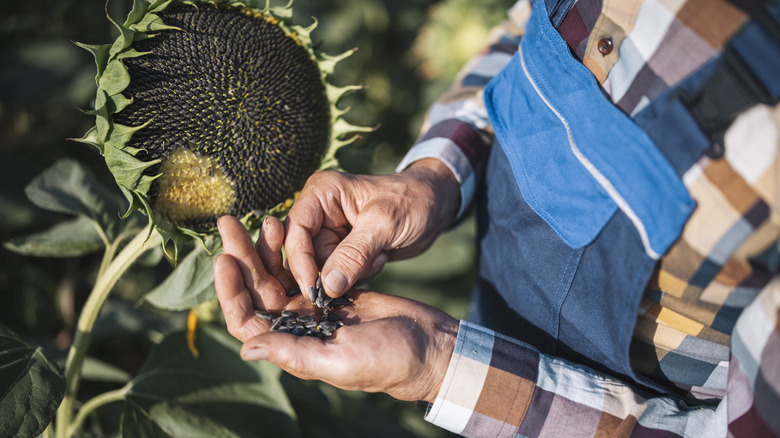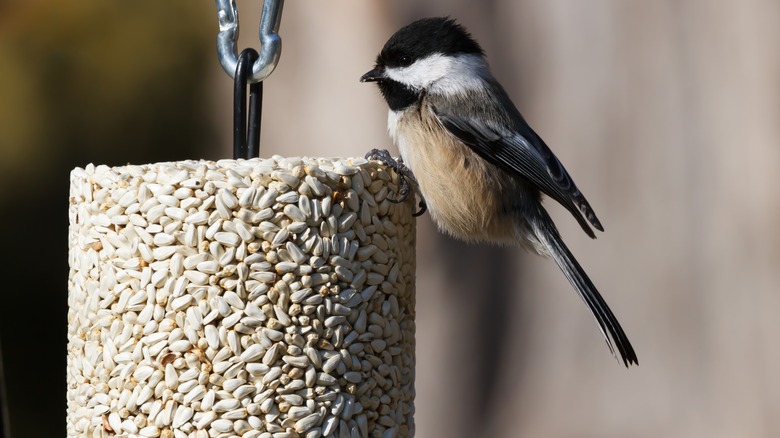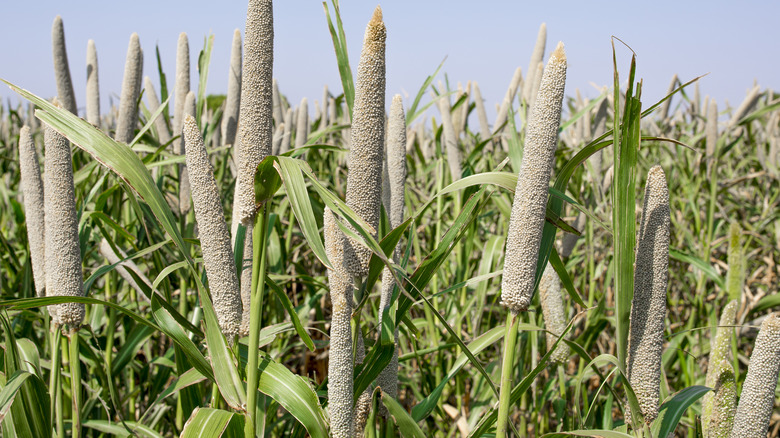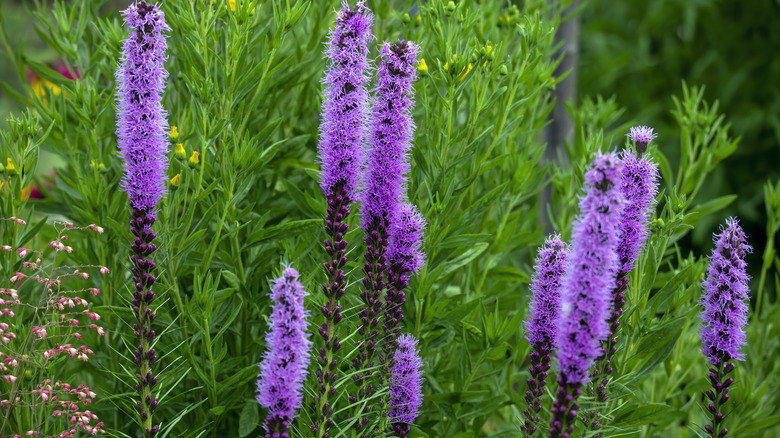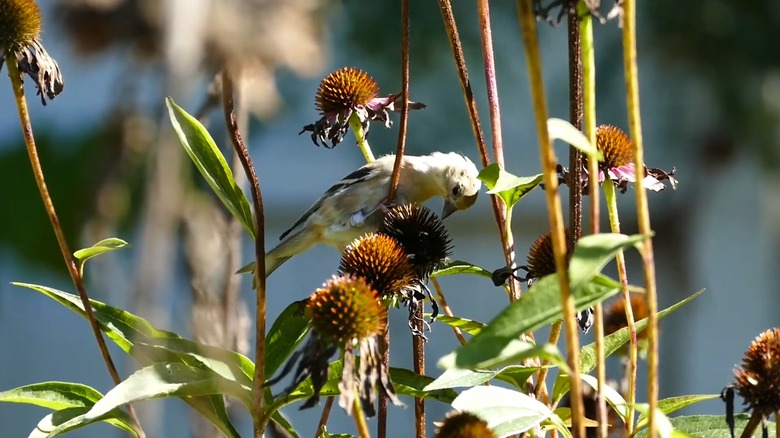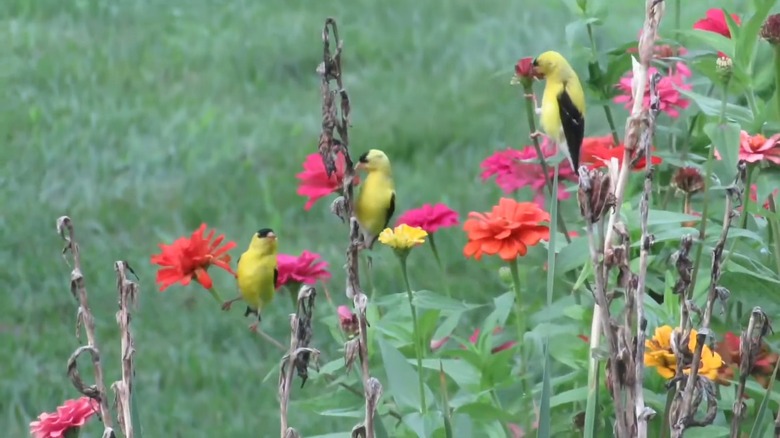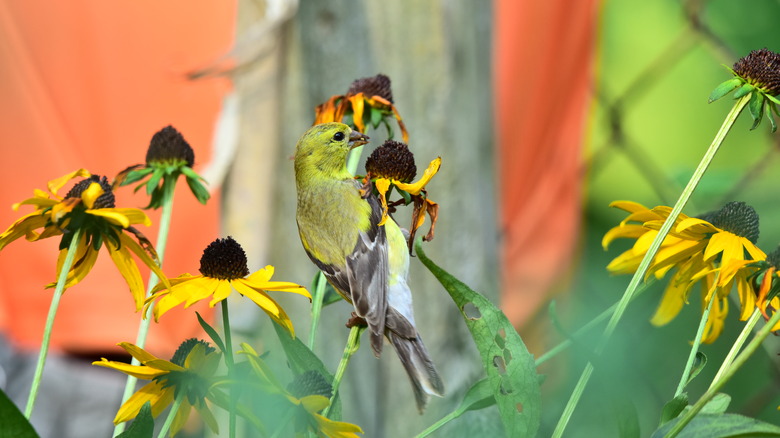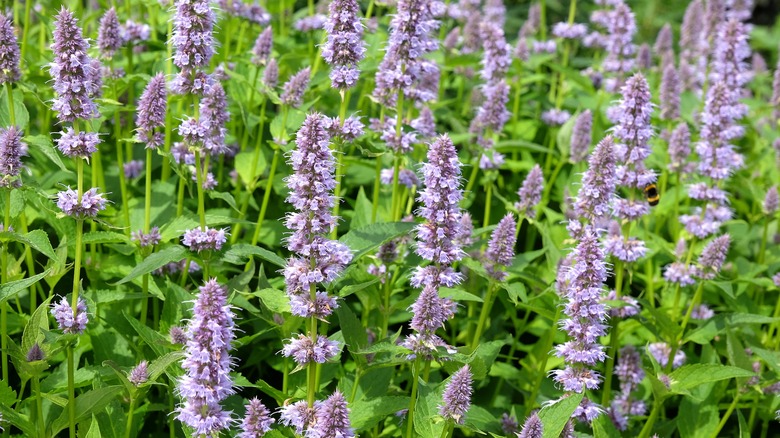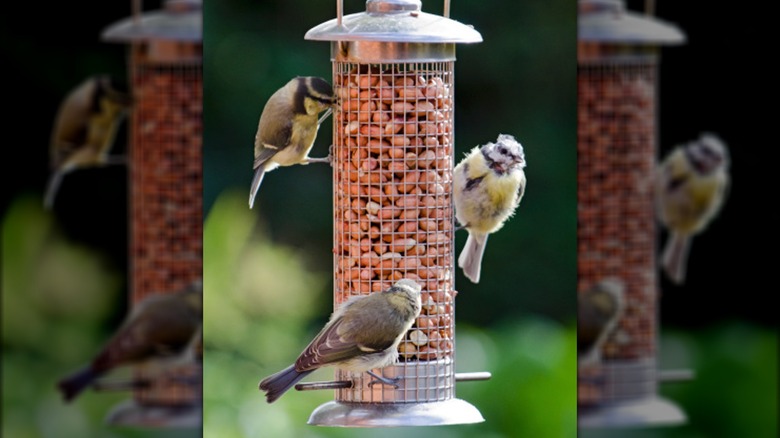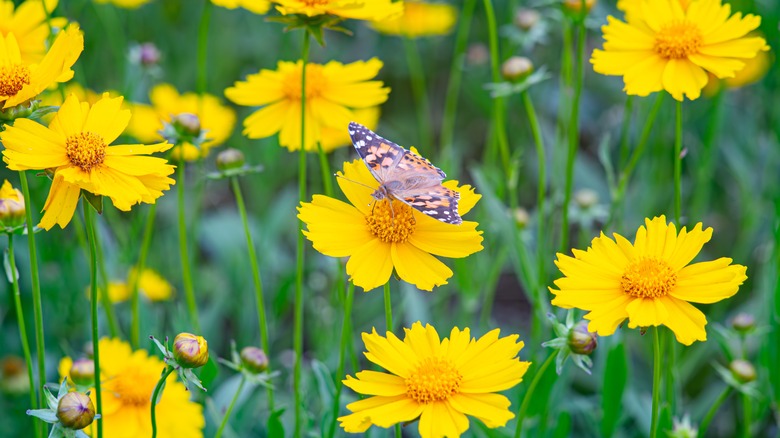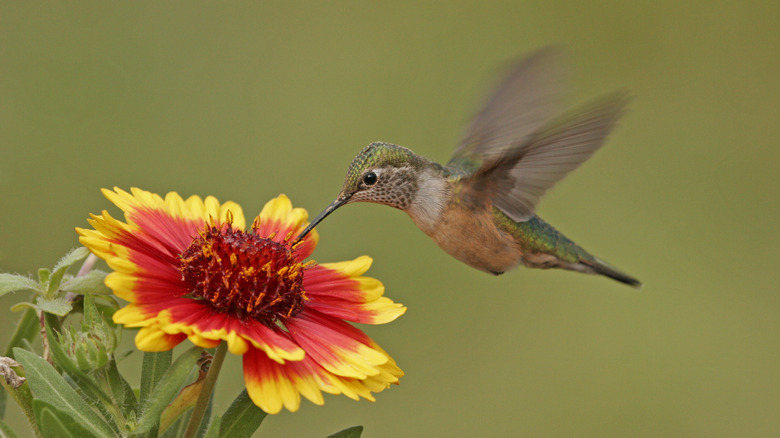Make Your Own Birdseed By Growing These Beautiful Plants In Your Garden
Watching birds in action can be deeply gratifying. Whether they're collecting twigs for nests, performing a mating dance to seduce new partners, throwing tantrums at an intruding counterpart, or rummaging through the garden beds for insects, their antics are playful to the core. So, it's no surprise homeowners deck out their yards with multiple bird feeders to befriend these feathery strangers. However, the costs can balloon quickly if you manage to successfully attract more songbirds to your garden. Feeding big broods is expensive, after all. Plus, multiple droughts and the redirection of grains toward biofuels have either raised the price of seed mixes or degraded their quality by mixing in filler grains like milo that, barring turkeys and sparrows, aren't liked by many. Worse, instances of commercial sunflower seeds harboring Sclerotinia stains have left many gardeners concerned for their plants.
Under such circumstances, it makes sense to make your own birdseed by growing beautiful plants birds like, such as sunflowers, safflowers, peanuts, and more. Besides, they're far easier on the pocket since they all can be started with seeds (no surprise). That being said, if you're tempted to sow commercial mixes, know they might not always work, as they're often heat-treated — imported nyjer seeds are a classic example. Instead, here are the diverse birdseed plants you can grow to feed a variety of birds year-round.
Sunflower seeds are a favorite of most backyard birds
Just like juvenile sunflowers (Helianthus annuus) trail the sun, myriad birds track their growth. They keep their eyes peeled for when the masses of buttery blossoms make way for the real deal — aka the seeds. From American goldfinches, black-headed grosbeaks, and mourning doves to chestnut chickadees and oak titmice, you'll be hard-pressed to find a feathered visitor who doesn't adore sunflower seeds. However, they have their preferences, favoring oil seed sunflower varieties (such as Black Peredovik) over confection varieties that are more suited to our palates. The reason? Oilseeds are easier to crack while offering more nutrients.
Luckily, growing sunflowers is a breeze since their seeds can be buried directly in slightly acidic, well-draining soils after frost or started indoors, ripe for harvesting in under 100 days. To make your own birdseed, shear the drooping flowerheads once they turn tannish-yellow and dry them in a secure place for a couple of weeks. These ripe seeds can also be sown next year to bring the songbird magic back to life. Alternatively, let the seeds be, and extend the season by either planting the same variety at two-week intervals or planting different sunflower species with successive blooming times. Deer, rabbits, and squirrels might join the feast unless you fence the annuals or spray repellents. Remember to clean up the discarded hulls, lest the allelopathic particles stunt the surrounding vegetation or turfgrass.
Safflower seeds attract birds but deter rodents
Safflower (Carthamus tinctorius) is an easy-to-grow plant worth adding to your garden to avoid buying birdseed. It grows sunflower-like glossy white seeds, except they're much harder to crack. This bounds your birding options to purple finches, northern cardinals, mourning doves, chickadees, and other larger birds who have no trouble breaking through the hull for nutrition. But this limitation encloses a categorical advantage, too, as notorious seed raiders, such as squirrels, European starlings, and house sparrows usually steer clear of these plants, moving elsewhere. That being said, safflowers look quite remarkable in the yard with their thistle-resembling yellow or orange flowers, and the bees enjoy them as they bounce from bloom to bloom.
Like most plants, safflowers aren't fond of being transplanted. So, they should be directly seeded in fertile, well-draining soils when they thaw after winters. It isn't unusual to find these plants growing of their own accord under feeders when their seeds were chucked out by famished birds. They're highly drought-tolerant, as you would expect of a crop with a 10-foot-long taproot. But they aren't suitable in wet areas where annual rainfall exceeds 15 inches. Given their cold sensitivity, they need a minimum of 120 frost-free days to produce good seeds. Moreover, as their maturity often aligns with fall rains, it's best to harvest the seeds when most green bracts turn brown, or they'll sprout.
Pearl millets add decorative, vertical interest to yards
Often touted as a cover crop that will help suppress weeds with its deep-rooting, quick-spreading, over 4-foot tall grassy blades, pearl millets (Pennisetum glaucum) also serve as bird food. Just ask the juncos, mourning doves, quails, and goldfinches milling around it. They're quite popular as garden accents ever since the University of Nebraska gave them a facelift by introducing the 'Purple Majesty' cultivar that grows ornamental bottlebrush-shaped flowers, eventually setting white or tan seeds. This also empowers gardeners to enjoy a load of other benefits, including erosion control, soil enrichment, and better drainage in compacted soils.
Hailing from the Sahel region, pearl millets are popularly cultivated in the continental US states as long as the temperatures exceed 91 degrees Fahrenheit during peak summers. In fact, the higher the light and heat exposure, the better their performance. Also, these drought-resistant plants shouldn't be ground-seeded directly, especially in cooler climates with short growth seasons. Instead, sow them indoors and move them into loamy or sandy soils after frost. Make sure the substrate drains well, or they'll rot. If you wish to save their seeds, harvest the grains when the foliage is still drying, 40 days after blooming.
Blazing stars provide fall food
Although blazing stars (Liatris spicata) or gayfeather plants might never cross your mind for birdseed — blame the grain domination in commercial mixes — they should. These stunning perennials don't just impress butterflies, specialist bees, hummingbirds, and thread-waisted wasps. They're irresistible to songbirds, too. After they're done blooming their pretty lilac (or white) heads, they produce copper-toned cypselae (their version of seeds) that finches will devour. Chickadees might drop in for a nibble as well. The best part, though? You can achieve the same results with any other Liatris species native to your area (there are over 13 options to choose from!).
While you might know of blazing stars as popular summer bulbs, they can also be grown from seeds — indoors and out. However, moist cold stratification, refrigerating the saved seeds with a moist paper towel or peat in a sealed plastic bag for around six weeks, is necessary to break dormancy and improve their performance. Alternatively, you can plant them in the ground in early winter days, provided you have acidic soil that drains well. Blazing stars require full sun and staking, as some cultivars can grow quite tall, especially in fertile soils. Don't overcrowd the beds, as they risk contracting fungal diseases, including rust, leaf spots, and powdery mildew.
Purple coneflowers keep birds fed through the winter
Ubiquitous in prairie planting mixes, purple coneflowers (Echinacea purpurea) have earned their right to stick their cones into the packets of birdseeds, though songbirds couldn't care less about the semantics. What they do care about is tracking the violet or pink flowers, which develop tiny black seeds as the summer sets in. While you'll be tempted to deadhead the faded blooms to induce reblooming, keep a few aside for the chickadees and goldfinches to munch on. Also, leave the second flush's heads on through the winter, so your feathered friends have something to look forward to when other food sources are scarce.
Endemic in the central US states, purple coneflowers are a great planting choice for gardeners rocked by challenging conditions that run the gamut of drought, humidity, salt, poor fertility, and even deer pressure! Indeed, this beautiful plant will even thrive in clay soil, provided it's given at least six hours of direct sun exposure. Although aster yellows, leaf spots, Japanese beetles, and coneflower rosette mites bother coneflowers occasionally, they're generally pest- and disease-resistant. The perennials are self-seeding, so feel free to save a few to put in your feeders, or they will spread, necessitating division. If growing new purple coneflowers with the saved seeds in other garden sections, cold stratify them before sowing to ensure germination success.
Zinnias set out a late summer spread for birds
You might've treated zinnia (Zinnia spp.) as the colorful flower that'll upgrade your garden's tomato game. Or, as another daisy family pollinator-friendly annual that plays host to a hoard of butterflies, bees, and hummingbirds. But as a source of birdseed? Probably not. Yet zinnias do a grand job of attracting American goldfinches and pine siskins. You might reckon that these songsters stalk the colorful plants to stay on top of when they're aglow in stellate flowers. And once they do, they leave no leaves upturned (literally), putting the most aggressive foliage nibblers, including earwigs and leafhoppers, to shame. Make no mistake, though; the birds haven't developed a penchant for foliage. They're simply trying to get to the sunflower-esque seeds at their base.
Growing zinnias is probably the easiest way to give credence to your gardening abilities if the site is bathed in sun for at least eight hours. Not only are they easy to plant — via direct seeding and seedling transplantation — and maintain, but these rapid growers are also quick to blanket the garden beds in a wash of different colors, even if you're late to planting. Pay attention to spacing, as crowded beds become breeding grounds for powdery mildew. Also, prune early if you want to rejig their growth habit because, to attract songbirds, you'll need to let go of the plant. Don't forget to harvest a few zinnia seeds for next year.
Black-eyed Susan serves winter interest (and appetizers)
Embodying the spirit of the perfect fall flower that's even deer-resistant, black-eyed Susan (Rudbeckia hirta) has garnered an intensive following among native plant enthusiasts, willing to go the mile (or not since they're low maintenance) to turn their green expanses into wildlife meadows. While the brown-eyed, yellow-rayed flowers look splendid when dotted by equally enchanting silvery checkerspot and emerald butterflies, their true utility lies elsewhere if songbirds were in charge. To them, the magic starts in the fall when the Susans put out their seed-encapsulating brown fruits, and lasts until the plant is cut back to the ground. Hopefully not until spring if American goldfinches, northern cardinals, chickadees, verdins, and white-breasted nuthatches were to enjoy a gala time amidst the winter chill.
While Rudbeckias can be grown from seed, you must subject them to cold stratification, as you did for blazing stars, but for over 10 weeks. Otherwise, they're best gotten as small nursery plants and transplanted in wet soils receiving the most sun (slight shade is tolerated). As black-eyed Susans are prolific self-seeders, they'll take over your garden if birds and mammals are doing a poor job of finishing off the seeds, so keep track if you've got other bedding plants to save. Look out for verticillium wilt, downy mildew, and goldenglow sawflies, as they can severely damage (sometimes kill) the plants if not spaced well.
Anise hyssop flowers support birds during harsh winters
Sometimes, all you need to do is plant anise hyssop (Agastache foeniculum) rather than going to abject lengths of hanging bird feeders, researching the feathered visitor's food preferences, and protecting their refreshments from varmints. The mint family relative smells delicious, albeit closer to a basil than its namesake, anise. Its lavender spikes put on quite the show from summer through fall, not that we or the swarm of butterflies, honeybees, or hummers are complaining. Songsters like juncos and finches actually look forward to the event, for they know the seeds will be here anytime soon — unless you dash their dreams by deadheading. While multiple flushes are nice, it serves the songbirds better if you allow a few flower stalks to set seeds mid-season while the rest can wait for the final blooming round to finish.
Anise hyssop plants can be grown directly with seeds after they've undergone a month-long moist stratification. Just give them full sun and good drainage, as they're cavalier about everything else. After that, they're good on their own, armed as they're with self-seeding tendencies. But if you believe the birds are sparing no seeds, you can harvest a few by covering a spent bloom with a plastic bag and aging it until it's fully dry. Separating the seed from the faded flowers is usually a hassle, and they can be planted as-is. However, avoid saving with hybrid cultivars, as they don't grow true to the parent.
Peanuts are good when shelled and garden-fresh
Although plenty of backyard visitors, including titmice, chickadees, blue jays, and woodpeckers, love peanuts (Arachis hypogaea), they often feature on avoid lists, as stale nuts can harbor bacteria and harm the birds. The situation is especially precarious during the rainy season. However, you can turn the odds in your (and the avians') favor by growing peanuts, or goober peas, in your garden and serving them fresh!
As peanuts usually require at least 120 frost-free days to come into their own, you must choose the variety wisely, especially if your area has a short growth season. 'Early Spanish,' 'Jumbo Virginia,' and 'Virginia Improved' fit the bill for most home gardens, as they mature early. That being said, peanuts are a curious lot, as their seeds grow out as sunny yellow, pea-shaped blooms. However, they don't produce their characteristic earthy nuts after the flowers have faded out. Instead, they send pegs (stalks) into the ground, which mature underneath. That's why peanuts can't be grown in compacted soils, although cultivation might help (while keeping the weeds down). Worse, not all flowers shoot out pegs. A mere 15% do, so be prepared for such an outcome. When the foliage yellows in early fall, you must prod the plants out and air dry them for two weeks. Later, remove the peanut pods, dry again for two weeks before adding to the feeders. Spoiler alert: squirrels, raccoons, and bears might give birds fierce competition.
Coreopsis lanceolata lay out a late summer treat
Another wildflower favorite, lanceleaf coreopsis (Coreopsis lanceolata) or tickseed has a weighty advantage over other ornamentals by enticing the birds into your garden for cypselae (seeds). Luckily, these delights lack the stiff bristles typical to other tickseed species, saving the goldfinches and the gardeners a whole lot of trouble. Endemic across the US, coreopsis is prized by gardeners for its bronze yellow or orange flowers, emblematic of the Aster family. It lends even greater service by attracting lots of beneficial insects, including the insidious flower bug (Orius insidiosus) that picks off western flower thrips and dance flies (Empididae) that prey on insects. Not to mention, bees are happy to meander around their blooms from spring through summer.
Lanceleaf coreopsis can be started easily with seeds in the fall or winter, although they will flower only after they're well into the second year. Give them over six hours of sunlight and site in rocky sites or slightly moist soils. Removing spent blooms will induce reblooming but will deprive the birds of seeds, so create a balance accordingly. If you feel the need to save some seeds for new plants or for feeders, harvest early as their seedheads are easily broken. Air dry the seeds on a paper towel for a few days, seal them in a bag, and refrigerate until you use them.
Indian blanket flower's seeds are relished by small songbirds
Festooned by bi-color, disc-shaped flowers in a kaleidoscope of red, yellow, or orange hues, Indian blanket flower (Gaillardia pulchella) was named after the bold patterned designs common to blankets woven by Native Americans. Besides the historical significance, these annuals double as birdseed plants, assuaging the hunger of goldfinches and their smaller singing brethren. They're often interplanted with similar birdseed plants, including purple coneflowers, coreopsis, rudbeckia, and sunflowers to create the perfect package.
However, growing Indian blanket flowers isn't straightforward because they can be sensitive about drainage. Wet soils may cause rot, cutting their already short life even shorter. Hence, they're best popped in sandy soils in full sun. Although their seeds can be sown directly into flowerbeds after frost, they can be confused for dandelions in their seedling stage. So, the other option is to grow them indoors around six weeks before the last expected frost and transplant later. Gaillardias are fast growers, blooming within three months of sowing. Avoid deadheading so that birds can harvest the seeds on their own.
